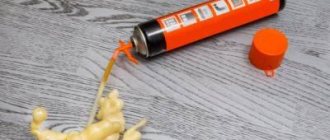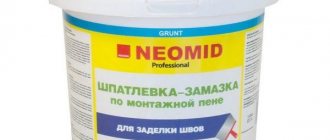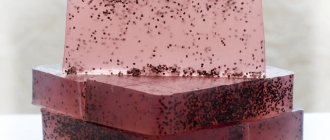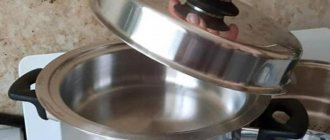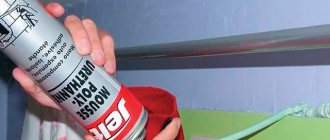Polyurethane foam is a widely used building material, the frequent use of which is due to its adhesive properties.
It is recommended to work with polyurethane foam only with gloves, but not everyone follows clear instructions, as a result of ignoring which it becomes possible to find out how corrosive the material used is.
Today we will try to figure out how and how to wash foam from your hands.
Removing fresh foam
As soon as foam gets on your skin, you should immediately remove it with a damp cloth or cloth. Do not rub the stain on the skin, so as not to aggravate the situation.
You can clean fresh foam sealant using traditional methods, for example, salt, dimexide, gasoline, sunflower oil. Start with the options that are most gentle on the epithelium.
Vegetable oil
The method will not harm the skin, but to be effective you will have to stock up on time and patience.
- Heat the oil slightly and soak a cotton pad in it.
- Place it on the contaminated area and leave for half an hour.
- Wash your hands thoroughly with soap.
Attention! The oil for the procedure should be warm, but not hot, so as not to get burned.
Salt
If the contamination is minor, you can use coarse table salt for cleaning. Rub your hands thoroughly with salt and then rinse with water.
We recommend reading: The drum in the washing machine has stopped spinning. Causes of failure.
Nail polish remover, kerosene, gasoline, acetone
These products will only bring results if the construction foam on the skin has not had time to dry completely. Soak a cloth in the liquid and wipe off the dirt. At the end of the procedure, be sure to wash your hands and lubricate with nourishing cream.
If nail polish remover is not available, use acetone. You can also remove foam from the skin with kerosene or gasoline; they are used in a similar way.
Dimexide
Before scrubbing the foam with dimexide, you should assess the extent of the contamination. If large areas are stained, it is better to choose another method, since the medicine, being absorbed into the body through the pores, can cause a side effect due to an overdose.
Is it possible to remove polyurethane foam with alkali and acid?
Aggressive chemicals actively attack the composition of the sealant, destroying it. But they can cause serious skin burns; under no circumstances should they be used to cleanse hands.
The only safe option is a steam bath with soda, which is known to be alkaline. Add a couple of tablespoons of soda to hot water and hold your hands over the container for half an hour. After this procedure, the softened sealant can be easily washed off.
Useful tips
- After repair work, carefully inspect all surfaces. And also pay attention to the fittings (door handles, hinges, etc.).
- If you notice dirt from polyurethane foam, start cleaning immediately, otherwise it will be much more difficult to clean the stained mark later.
- Do not use water during the removal process. It will only make the situation worse and the stains will harden much faster.
- When using chemicals, do not forget to protect yourself. Wear protective gloves and a respirator or cotton-gauze bandage. Removal work should also be carried out in a well-ventilated area.
- Before the cleaning process, perform a test on an inconspicuous part of the surface. Only if it is not damaged, you can apply it on the stained area.
Try to prevent foam from getting on your skin and things. Agree, it is easier to cover the floor, cover doors, windows, etc. with protective film, than to scrub it all off later.
How to wash foam from hands if it has dried
You can’t get away with this with a damp cloth; bring in the “heavy artillery” in the form of rough mechanical cleaning or solvents and special means.
Solvents
White spirit and similar preparations are effective in removing foam from the skin, but at the same time they dry it out greatly. Dampen a clean cloth with the product and cover the stain for a few minutes, rubbing the stain to enhance the effect. Next, wash your hands thoroughly using glycerin soap, then lubricate with cream.
Special liquids, aerosols
You should think about how to remove sealant from any surface before starting construction or repair work. Along with the polyurethane foam, it is advisable to purchase a product for its removal; as a rule, it is sold in the same store in the form of a liquid or aerosol. Before use, be sure to read the instructions and follow them strictly.
We recommend reading: How to avoid flooding your neighbors: fixing the washing machine drain
How to prepare to work with foam
If the performer does not use gloves for any reason, then it is recommended to generously lubricate your hands with Vaseline or rich cream , which reduces the degree of adhesion of the foam to the skin of the hands. And it will be easier to remove dirt. But there is a risk that the cylinder will slip out of your hands.
Respirator Source FFP1 with valve. Photo by Leroy Merlin
The use of a mask and gloves is highly recommended; an alternative to a mask is safety glasses.
It is recommended to carry out the work either in special clothing or in things that you would not mind throwing away at the end of the work, since it will be difficult, but possible, to remove the composition from clothing without causing a change in color or structure.
Surrounding furniture and surfaces not intended for applying foam must be protected with film.
If the contractor does not have a very high level of qualifications and experience in construction, it is recommended to first purchase special foam removal products . They allow you to quickly remove dirt. And there is no need to save money, especially when choosing a hand sanitizer. Poor quality products can lead to adverse reactions.
It is recommended to carry out work with an assistant , which minimizes the likelihood of contamination.
How to wash polyurethane foam from your hands: important recommendations
Some more useful tips.
- Cosmetic scrubs, which have many beneficial properties, are useful for removing foam sealant from the skin. They have a mechanical effect on the affected area, and at the same time nourish and moisturize. Use the products according to the instructions.
- Any procedure to remove dirt from the skin must be completed by thoroughly rinsing off the cleanser with any remaining foam with water. It is also advisable to treat the surface of your hands with a cream that has antiseptic and regenerating properties.
- If traditional methods do not cope with the task, and you do not want to purchase a special liquid, there is only one way out - wait until the sealant disappears on its own. On average it takes 2–3 days.
You cannot try methods not described in the article without firm confidence in their safety. Some remedies may not only be ineffective, but also harmful to health.
What should not be used to remove the mixture from skin, nails, hair
An important task is not only the effective removal of contamination, but also the minimization and, optimally, the elimination of damage to the skin. Therefore, it is important to carefully choose products for cleansing your hands, nails, and hair. Experts note the following substances that may be dangerous :
- acids and vinegar ; they are not able to break down the composition and can leave burns, so you need to exclude these products in order not to encounter health problems;
- chlorine-based products that have a negative effect on mucous membranes are prohibited from contact with skin;
- alkalis are not intended for removing foam and may cause burns;
- Dimexide , careless use of which can lead to overdose or allergy.
How to protect your hands and not get dirty?
Before working with construction foam, take precautions. Wear thick gloves and remove them after installation.
Even if you handle the cylinder or gun correctly, there is a risk of getting dirty with polyurethane foam. Contact with the skin of the hands can cause damage to epithelial cells. If trouble does occur, do not panic, because there are professional means and folk methods for cleaning polyurethane foam. Any method must be used carefully, following the instructions, so as not to cause even more harm to the skin.
We recommend reading: How to avoid flooding your neighbors: fixing the washing machine drain
How can you remove it when it's dried out?
To remove sealant that has already dried, you will have to resort to a mechanical method; solvents will not cope with the task. The skin is generously lubricated with a rich cream and the dirt is carefully wiped off with a pumice stone or a stiff brush. You can scrape off the dirt well with your own nails. Fine sandpaper can also be used, but it must be used very carefully to avoid damaging the leather. After removing the sealant, your hands must be re-treated with cream.
Varnished surface
Solvents are not suitable for it. They often damage the varnish coating. The foam is removed until it has completely hardened, but no longer sticks. To do this, use a plastic spatula.
Glass
It can be cleaned without special means, since the foam does not penetrate into the structure of the material. First cut off the “cap” and then take a sharp blade and carefully scrape off the remaining part.
Laminate and linoleum
The foam seal is well fixed to the relief pattern. Wait for it to harden and then cut. Remove what's left with sunflower oil. Apply for 20 minutes, wipe with a cloth, and wash with soapy water.
Metal-plastic windows and doors
Professional cleaners and store-bought products are used to remove contaminants. White spirit, Dimexide and others are suitable.
Wooden structures
The best option. The polyurethane foam is removed from wood using household abrasive or sandpaper. If scratches appear, remove them with polish.
Steel door
Metal doors are first cleaned with the blunt side of a knife. The top lump is cut off. Residues are removed with vegetable oil, a brush or a soft scraper. To avoid scratching the surface, use a plastic scraper.
Carpet covering
The most difficult thing to remove polyurethane foam from textiles and carpets. On them it is immediately absorbed and eaten into the fibers. The easiest way is to cut it off with a utility knife or try to scrape it off with a spatula.
In some cases, gasoline or kerosene will work, but test in an inconspicuous area first.
Many repairs involve the use of polyurethane sealant. Without it, it will not be possible to insulate the balcony, install doors and windows. The material is known not only for its high adhesive properties, but also for its ability to quickly dry out, stick, and eat into clothing.
If you don’t know how to wash foam from your hands , remember: there are not many options. Try not to let it harden to make it easier to remove. For the body, soft mechanical methods are preferable, since any chemical cleaner is harmful to the skin.
When the foam has already dried
If you did not have time to immediately clean your hands of foam, and the composition has already dried, then much more effort will be spent. You can cut off the top layer, but the one that is in direct contact with the hand itself will have to either be soaked with a solvent, or try using dimexide. This popular and inexpensive drug (anti-inflammatory and antimicrobial agent) is an oily liquid, sold in pharmacies in containers of 50-100 ml.
As when working with a solvent, the fabric is impregnated with dimexide and applied to the smeared area. After some time, the foam will dissolve, after which it’s time for soap and water.
Effective ways to clean foam deposits from a gun
To keep the tool in working condition, take care of its cleanliness regularly. Foam deposits should be washed off immediately after finishing work, while the sealant is still fresh and not hardened. To do this, before starting repairs, think about how you will carry out cleaning and take care of purchasing a special cleaner or solvent.
Washing with aerosol cleaner
At the end of the work, the container with polyurethane foam is removed from the unit, but a large amount of sealant remains in the barrel, which quickly dries out and in the future interferes with the normal functioning of the unit. A simple method that involves using a special cleaner will help you cope with the problem. Purchase the product at the same time as purchasing the foam and choose formulations from the same company, for example, Staye, Profflex, Atoll Cleaner, Hauser, Germez, Dali, etc.
Start cleaning the construction gun immediately after finishing work, since washing off fresh sealant is much easier than removing dried foam
Aerosol rinsing procedure:
- Read the instructions and rules of use.
- Install the cleaning aerosol into the adapter.
- Turn the barrel away from you and pull the trigger.
- Clean the device until clean liquid flows from the barrel.
When working with the cleaner, observe safety precautions:
- Do not clean near fire or heat appliances, keep the can away from direct sunlight;
- avoid contact of the substance with eyes, mucous membranes and skin;
- After using the cleaning product, ventilate the room well and wash your hands with soap.
Cleaning a gun with dried foam
If the tool could not be cleaned immediately after finishing work and the sealant had time to set, follow these steps:
- Using a utility knife, cut off the remaining foam from the base of the barrel and drop a little solvent onto it.
- Lower the barrel, wait a few minutes, and then try pulling the trigger. Do not apply significant physical force to avoid damaging the instrument.
- If the trigger doesn't move, drop a little cleaner onto the ball located where the bottle is screwed on. This will clear a valve that is clogged with foam. After 20 minutes, attach the cleaning spray and clean.
Mechanical cleaning of a construction gun
If there is significant contamination, it is necessary to mechanically clean the gun, which includes three stages: disassembly, cleaning and assembly. To complete the process correctly, please read the detailed description of each step.
Disassembly. To begin with, from the outer part of the tool, use a stationery knife to cut off the sealant that has managed to harden. Carefully unscrew all parts to be removed. Disassemble the tool slowly so as not to damage the threads and working elements.
Cleaning all elements. Clean all parts using an old rag, utility knife, wire or thin tube. You can clean the mounting gun from dried foam with cleaner, acetone, gasoline, White Spirit, nail polish remover or Dimexide.
To properly clean a construction gun, it is necessary to disassemble it and wash each part separately using special products or solvents.
Cleaning procedure:
- Cut off large areas of dirt with a utility knife. Proceed carefully so as not to scratch or damage the working parts.
- Soak small parts in the selected solvent and then clean with a stiff brush.
- Place a few drops of solvent into the barrel to soften dried foam.
- Using a homemade cleaning rod, clean the hole until the wire runs freely along the entire barrel.
Assembly. Reassemble the cleaned instrument and wash it again using an aerosol.
Mechanically cleaned tools should be washed again with a special cleaner after assembly to achieve maximum results.
To extend the life of a construction gun, buy a high-quality dismountable tool made of metal, and also make sure you have a solvent that will allow you to quickly and easily clean the device. Start cleaning the unit immediately after finishing work, since fresh foam is much easier to clean than hardened foam.
Aerosol – solvent
First of all, before starting construction work, you need to purchase a special aerosol. It is available for sale in almost every hardware store. It is advisable that it be from the same manufacturer that produces foam. Typically, this product is used to clean the foam from the gun used to apply it. Available in aerosol form, which greatly simplifies its application to the desired location. Simply spray on the contaminated area and rinse with warm water.
Such a solvent will only be effective if the foam has not yet hardened.
Products that should not be used
These products effectively dissolve foam, but are not suitable for removing it from the skin, as they can cause chemical burns:
- "Purex"
- "Termite",
- "Russian professional"
- PENO-OFF
- HOBBY.
Also, don't use sandpaper. Indeed, with its help you can easily remove foam from a wooden surface, but it is absolutely not suitable for leather.
Using vinegar or other acids will be a big mistake, since it will help little against foam, but will leave a burn on the skin.
How harmful is polyurethane?
As we have already said, polyurethane foam consists of two components: polyol and isocyanate. Their mixture is polyurethane.
It belongs to the group of chemical elements known as synthetic polymers. If they are not used correctly, they release toxic substances into the atmosphere. They can cause chronic poisoning syndrome in people. To prevent this from happening, when using it, there must be complete hardening.
If this type of sealant gets on an area of skin, it can cause irritation and, in some people, an allergic reaction.
When working with this sealant, follow safety precautions. Take gloves, a respirator, and old clothes. We never know for sure that the substance, even by accident, will not fall into our hands. Therefore, it is also better to take some kind of product that can remove dirt.
